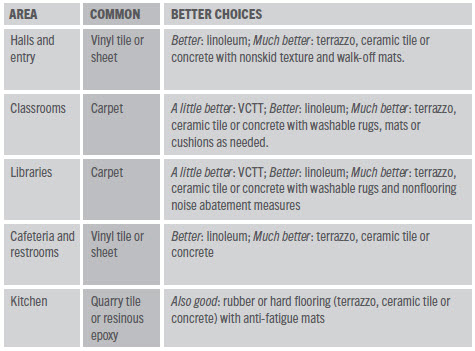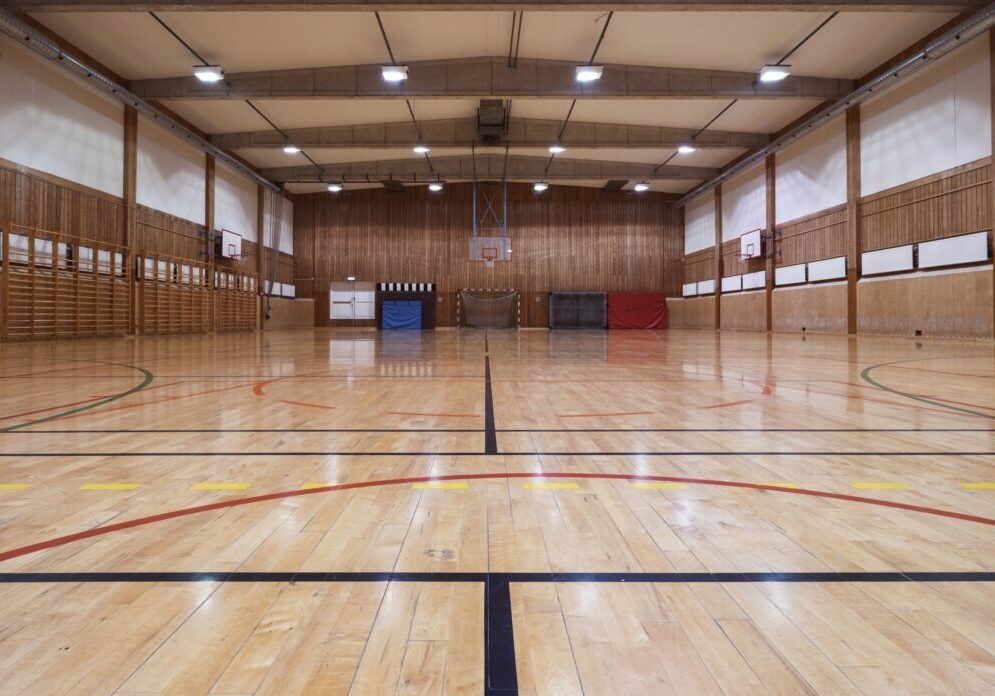Published in the January 2015 NJEA Review
by Frances Gilmore
You have probably experienced, or heard about, wet and moldy carpets associated with allergies and asthma, and you may be ready to advocate for a change at your workplace. But to what?
There are several factors to consider:
- Initial and lifetime cost.
- Possible harmful emissions from flooring, adhesives or cleaning materials.
- Safety from falls.
- Comfort to sit on.
- Sustainability.
- Noise and glare abatement.
The pros and cons of several options are discussed here, and the best options are summarized in the chart. Local associations should work with their UniServ field representatives and district to select the best options for their schools and workplaces.
Carpet, an air pollution nightmare
In the 1960s carpeting became popular for its low cost, comfort and control of noise and glare. But it came with problems. Carpet adhesives may give off volatile organic compounds (VOCs), long after installation. Porous backing allows water from cleaning, spills, leaks or floods to penetrate to the backing and subfloor, where it remains, favoring the growth of mold. The fuzzy, top part of the carpet also retains dirt and pollutants from shoes or other sources.
Mold and pollutants become airborne as people walk on the carpet and can cause respiratory problems. To minimize air pollutants, carpets need scrupulous—and costly—maintenance and often must be repaired or replaced well before the warranty is up.
 Better, not best, choices
Better, not best, choices
Vinyl composition tufted textile (VCTT) retains the advantages of conventional carpet with fewer problems. It is made from a very dense low-tufted textile that gathers less dirt than conventional carpet. Most importantly, it has an impermeable backing and allows for impermeable welded seams. When it gets wet, it is able to hold liquid above the subfloor and backing until professionally extracted. However, the surface can harbor mold and mildew within 24 hours, so timely cleaning is important after a flood.
Resilient flooring—vinyl or linoleum tiles or sheets—is popular because it is low cost and easy to clean. Vinyl is made from highly toxic polyvinyl chloride (PVC), which it can emit in a fire. It also contains and emits toxic phthalates, though some new phthalate-free products may be available. There may also be toxic emissions from adhesives, sealers, waxes and strippers. Linoleum, without asbestos, is a better choice because it is a natural, sustainable product. It contains linseed oil and may emit vapors. They are nontoxic but irritating to some people.
Hard flooring: best choice
People of a certain age will remember terrazzo floors—chips of marble or other material in a cementitious matrix—which were widespread in schools in the 1950s. The background pattern of this page is one style of terrazzo. Hard flooring includes terrazzo, concrete and ceramic tile. These have an upfront cost somewhat higher than VCTT and resilient flooring, but because they require minimal maintenance and last up to 50 years, they are the cheapest in the long run. They are also made of natural materials. They are hard to fall or sit on, and thus benefit from washable rugs and mats in elementary classrooms where children sit on the floor. Slipperiness in halls in particular can be reduced by textured surfaces on concrete and ceramic floors.
Other sustainable flooring
Cork and bamboo are appealing choices for their sustainability, but they are much less durable than hard flooring, and their long-term cost is much higher than any of the other choices.
Maintenance is important
With any option, the ability to budget for appropriate maintenance, repair and replacement should always be considered, as well as training for maintenance personnel in the best methods to maintain good indoor air quality as well as preserve the floor.
Other considerations
Whatever the floors, they will benefit from walk-off mats at entrances to scrape dirt from shoes and prevent allergens and other pollutants from distribution throughout the school. Mats should not be extra thick (these may never dry) or attached to the floor; they should be capable of being picked up, cleaned and replaced when needed. Rubber backing prevents them from slipping.
If there is a problem with water under the slab that comes through to the subfloor, there will be a serious problem with impermeable floors, such as VCTT and vinyl tile or sheeting. The rising water cannot escape through the flooring, and can exert enough pressure to pop the flooring away from the subfloor. Clearly, abating the water problem is the way to go.
For more information
The original more detailed version of this article includes information about gym floors: Health Considerations when Choosing School Flooring, Frances Gilmore, Asthma Regional Council of New England.
The Greenguard Environmental Institute also has volatile emissions criteria.
A good overview: Flooring Materials—Life-cycle Costing for Educational Facilities, by Helena Moussatche and Jennifer Languell.
Frances Gilmore holds a Master of Science degree in Industrial Hygiene from the University of Pittsburgh, and is a consultant with the New Jersey Work Environment Council, which is a frequent partner with NJEA on school health and safety concerns.
